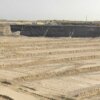Bulking occurs when the in-situ density of the material in the borrow area is not equal to the density achieved within the reclamation area.
Changes in volume
During dredging, transport, and discharge or placement of fill material, a change in the volume occurs. This can be either an increase or a decrease in material and can be caused either by a change of density (bulking) or by the loss of fine material.
A change in bulking may affect the total volume of fill material required for a reclamation project. Positive bulking, in which volume increases, implies that the in-situ density of the material in the borrow area is larger than the density required after deposition in the reclamation area. Negative bulking, that is, a volume decrease, is the opposite, that is, the in-situ density of the material in the borrow area is less than the density required after deposition in the reclamation area.
Estimating bulking
Since it is often very difficult to determine the in-situ density of the potential fill material in the borrow area accurately, bulking is usually estimated by using correlations between the cone resistance (or standard penetration test N-value), the effective stress, and the relative density.
The standard penetration test (SPT) is an in-situ dynamic penetration test designed to provide information on the geotechnical engineering properties of soil.
Once both the minimum and maximum density of the fill material have been determined in the laboratory, an estimate of the in-situ density can be made.


















